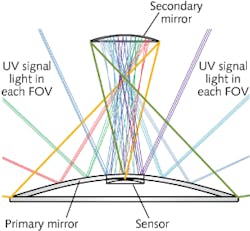UV optical antenna enables short-range nonline-of-sight broadband access

For some purposes, free-space optical communication in the deep-UV range is desirable. For example, because Rayleigh scattering is high in the UV, nonline-of-sight communication for short-range broadband access could be possible. In addition, the high absorption by the atmosphere in the solar-blind band means that distant observers would see none of the signal. In response, a group at the Beijing Institute of Technology (China) has designed an omnidirectional “optical antenna” consisting of a wide-angle reflective radially symmetric dual-mirror setup (mirrors axially separated by 100 mm) and a small field lens (not shown in figure), all pointed upward so that rays are collected from almost horizontal to almost vertical and directed downward to a 22-mm-diameter UV detector. One of the design constraints was that the incidence angles on a UV interference filter in front of the sensor fall within the filter’s operating angle.
In addition to the interference filter, the two mirrors were coated with surfaces that reflected mainly in the UV band of interest. A light-blocking diaphragm (also not shown), along with the field lens, help to reduce stray light. The light sensor was a photomultiplier tube (PMT). The entire package, which is enclosed in an 85% transmitting quartz cover to protect the optics, is 18 cm in diameter and 25 cm high. Outdoor experiments showed that the signal-to-noise ratio (SNR) of the optical-antenna/PMT combination was 31 dB higher than the SNR of the PMT used by itself. Contact Yi Tang at [email protected].

John Wallace | Senior Technical Editor (1998-2022)
John Wallace was with Laser Focus World for nearly 25 years, retiring in late June 2022. He obtained a bachelor's degree in mechanical engineering and physics at Rutgers University and a master's in optical engineering at the University of Rochester. Before becoming an editor, John worked as an engineer at RCA, Exxon, Eastman Kodak, and GCA Corporation.